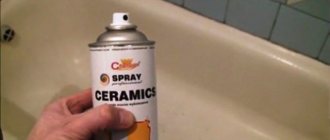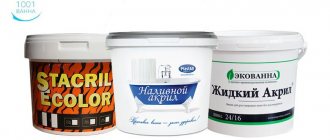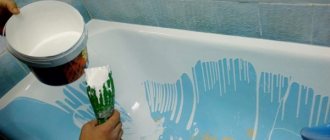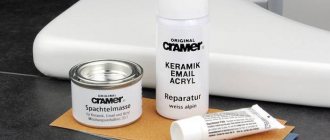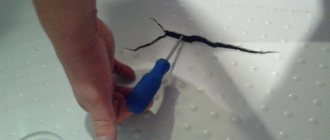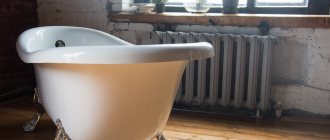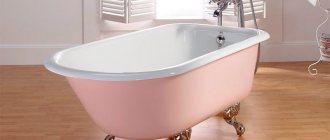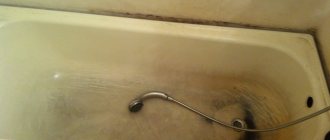Sooner or later, almost everyone is faced with the need to carry out renovation work in the bathroom. Since this particular room is used most often: for washing, washing, showering or bathing, the plumbing soon falls into disrepair. At the same time, the question often arises: which special bath paint is best suited.
If you have sufficient financial resources, you can purchase a new plumbing product, but sometimes it happens that the plumbing fixtures look normal in appearance, but the enamel coating needs restoration. And in order to restore the plumbing yourself, you need to decide what paint is best to paint the bathtub.
You don't have to be a real pro to understand that restoration requires special water-repellent bathroom paint. After all, conventional painting materials do not have sufficient resistance to moisture and adhesion, so coating plumbing fixtures with these types of paints and varnishes is not practical.
To avoid unpleasant consequences, special waterproof paint is used. The modern market is able to offer consumers a truly huge amount of materials for the restoration of plumbing fixtures, and in order to make the right choice, you need to understand what paint is best to paint the inside of the bathtub.
What bath enamels are there?
Manufacturers offer different coatings for bathtub restoration. What requirements must be presented to the paint in order to choose the best option:
- Safety - bath enamel should not contain impurities that can be harmful to health;
- Thermal conductivity - the lower this indicator, the slower the water will cool, respectively, the longer and more comfortable it will be to splash around in the new bathtub;
- Durability - if your task is not to simply add shine, but to solve the problem with bathroom enamel for a long time, then the chosen enamel should be resistant to mechanical and chemical influences.
What enamels for bathroom renovations does the manufacturer offer, and which one is better:
- epoxy - epoxy paint has been used to restore bathtubs for more than two decades. It is a mixture of epoxy resin, fillers and pigments. Refers to two-component enamels that require dilution with a hardener before use;
- acrylic - latex paint, which is based on acrylic, has been conquering consumers for just over ten years. In terms of durability, it is not inferior to epoxy enamels. It is a representative of two-component paints. As a rule, acrylic uses a pouring technique to cover the bathtub;
- alkyd - these water-dispersed compositions do not contain solvents, so they are practically odorless. If the application technology is strictly followed, bath enamel will last about seven years.
Epoxy
Alkyd
Acrylic
Features of sink repair
Through crack on the sink
Repairing a kitchen sink depends on the nature of the damage. During operation, the following appears on the sink:
- chips;
- cracks;
- scratches;
- the appearance changes: the enamel turns yellow.
At home, you can easily repair scratches and chips yourself. Restoring the sink will take a little time.
Several popular methods:
- It is quite simple to restore enamel if small cracks or scratches appear on it. For this purpose, special solutions are purchased - “enamel restorers”.
- The sink is polished and then tinted.
- Chips are more difficult to remove. The damaged area is puttied. This will help prevent water from accumulating.
When there is a problem with changing the appearance of the enamel, it will require much more effort to solve it. Rust spoils not only the enamel, but also the plumbing. Over time, it corrodes metal or plastic and changes the appearance of artificial stone.
The sharp edges of the chips are accompanied by minor microcracks. They should be eliminated as quickly as possible - water penetrates inside and destroys the structure of the sink. It is possible to restore the sink at home.
Repairing small chips and cracks in a ceramic sink proceeds as follows:
- The area is thoroughly cleaned.
- The crack is puttied.
- When the putty dries, the place where the crack formed is sanded again.
- Wipe off grease and dust.
- Using a spray can, cover the sink with the first layer of enamel or acrylic. After a while the procedure is repeated.
Putty for repairs is purchased at a hardware store. Based on the structure, it is worth choosing a two-component one.
There is another way to restore the sink:
- The surface is cleaned using coarse sandpaper.
- sand with fine sandpaper;
- apply enamel or liquid acrylic using a roller;
- shade with a brush.
The new shell coating differs in its structure from the factory-made one. It is less resistant to temperature changes, chemicals and detergents. It is worth carefully studying the manufacturers' advice and treating repaired ceramics with care.
Comparative characteristics of bath enamel
To determine which enamel is better, you need to know the pros and cons of each type, as well as how it is applied.
| Dye | pros | Minuses |
| Epoxy | Coating uniformity | Toxicity |
| Resistant to acids and alkalis | Once finished, the paint hardens very quickly. | |
| Does not erase | Possible leaks | |
| Suitable for metal and cast iron | Turns yellow quickly | |
| Acrylic | Maintains a presentable appearance for a long time | Acrylic is toxic |
| Resistance to mechanical damage | High consumption | |
| Low thermal conductivity | Do not use aggressive detergents | |
| Suitable for steel, cast iron, acrylic | Probability of detachment if technology is violated | |
| Alkyd | Non-toxic | Enameling requires careful surface preparation |
| Retains its original appearance for a long time | High consumption | |
| Suitable for all types of coating (including ceramics) | Difficulty of application |
Ways to paint a bathtub
To restore bathtub enamel, three main methods are used and everyone decides for themselves which one is better:
- bulk;
- enamelling;
- aerosol.
The pour-in restoration method, at first glance, is one of the simplest. More often it is used to restore a cast iron bathtub. Acrylic is poured onto the sides of the bathtub. Liquid paint flows down, forming a new coating. The pouring technique allows you to correct unevenness, close cracks and make the surface perfectly smooth. But using acrylic without experience or minimal skills is quite problematic. Drips may form.
Pouring technique
Enameling involves using a brush or roller. This method is used to apply enamel and paint. Horizontal strokes alternate with vertical ones to avoid drips. Without waiting for the enamel to dry, apply the second and then subsequent layers.
Painting a bathtub with enamel
The aerosol method is really the simplest. Spray paint does not need to be pre-prepared. It is possible to immediately choose the appropriate color. Before use, shake the can well for two to three minutes.
Aerosol use
An alternative way to update your bathtub is to install an acrylic liner. Particularly suitable for restoring an old cast iron bathtub. This coating is installed using glue. The method is fast, simple and effective. The only difficulty is in caring for acrylic. He does not like aggressive cleaning agents and is sensitive to mechanical damage.
Acrylic liner
Tips and recommendations for further care
When caring for a faience or ceramic sink, you need to observe a number of nuances, namely:
- You should not place shelves with dishes or cereals above the sink. If it falls, cracks will form on it. If they are large, the washbasin will need to be replaced; it cannot be repaired.
- When cleaning, do not use brushes, metal scrapers or brushes. They will violate the integrity of the surface and scratch the enamel.
- Detergents for white sinks should contain chlorine. For colored ones, their use is strictly prohibited. The appearance of the sink will deteriorate.
- To clean the surface, use a double-sided sponge; the “hard” part will easily remove dirt.
- Home remedies can help whiten your sink. For this you will need baking soda and vinegar. Apply a small amount to a sponge and remove dirt. It is important that the sponge is dry, otherwise the surface of the ceramic may be scratched.
In case of allergic reactions to chemicals, cleaning is carried out only with gloves. The faucet should be cleaned with the washbasin.
How to choose enamel
The coating to restore the bathtub to its former beauty is selected according to three criteria: application method, completeness and color. The application method - poured acrylic, aerosol or enamel - will depend on the degree of damage to the old enamel, the financial capabilities and skills of the artist. You can purchase all the necessary products separately. Some manufacturers produce bathroom enamel complete with a hardener, tinting paste, solvent and everything necessary for the preparation and process of refinishing the coating.
Using tinting paste, you can create any shade when restoring an old bathtub. It depends only on the taste, as well as the preferences of the owner. When purchasing two-component paint, you need to pay attention to the color of the hardener. A transparent, translucent or gray shade is better - the enamel component will not be noticeable after restoration. More saturated shades may leave spots and streaks.
Not only the final appearance, but also the durability and strength of the coating depends on the correct choice of enamel for bathtub restoration.
Aerosol enamel, advantages and disadvantages
The aerosol technique is one of the easiest ways to update a bathtub. When choosing this option to revive the coating, you need to consider the pros and cons of such paint.
Advantages of spray paint:
- it dries quickly (a few hours is enough);
- no additional tools needed;
- aerosol enamel fits better on the surface and has good adhesion, that is, it adheres tightly;
- a varied assortment: cans can contain two-component paints, acrylic, and so on;
- easy application.
Bath enamel in a can
Disadvantages of aerosol enamels:
- difficult to use to restore large surfaces: certain skills are required to avoid uneven tone and drips;
- the layer turns out thin, since the composition of the aerosol paint includes a large percentage of solvent;
- fragility: a thin coating cannot guarantee a long service life of a new bathtub.
Using this technique, it is easy to restore an old cast-iron bathtub or make minor repairs to an acrylic bathtub.
Restoring the enamel coating of a bathtub
The edges of the carefully sanded and cleaned bathtub are carefully covered with masking adhesive tape around the entire perimeter. The enamel is applied with a foam roller, making cross movements with it and evenly distributed over the entire surface so that there are no sagging or drips. The applied enamel is shaded with a flat brush, moving it from top to bottom, and then along the bathtub.
These articles may also be of interest to you:
- Cleaning and maintenance of plumbing equipment
- Replacing the siphon and sink drain
- How to disassemble a sink siphon
- Removing a blockage using a plunger with a pump
What else would you like to read?
Tags: restoration of bathtub cover, restoration of sink cover, restoration of enamel coating, restoration of bathtub enamel, restoration of sink enamel, bathtub repair, bathtub surface repair, sink surface repair, bathtub cover repair, sink cover repair, sink repair, chip repair, bathtub chip repair , sink chip repair, enamel coating repair, bathtub enamel repair, sink enamel repair
Types of aerosol paints
The modern market offers a large selection of aerosol enamels for baths and ceramics. Almost every manufacturer tries to produce bath paint in several formats, including aerosols or sprays.
Spray paint WHITEST New Ton
Aerosol New Ton is a Ukrainian epoxy-based bath enamel. The paint dries quickly and has excellent adhesion to enamel surfaces, which is especially necessary for restoration, for example, of an old cast-iron bathtub. The enamel is presented only in snow-white form. The volume of the can is 400 ml. Shelf life: 3 years. Cost – from 200 rubles per can.
It is important that New Ton provides a reliable coating with resistance to temperatures up to 100 degrees. The enamel does not peel off or crack. There is no need to prime the surface before applying New Ton. One layer dries in 6 hours, a completely multi-layer coating will dry in two days.
Enamel WHITEST New Ton
Enamel spray for baths and ceramics Kudo
Aerosol for baths and ceramics Kudo is a Russian alkyd-based enamel. Quick drying (no more than 5 hours), excellent adhesion to various materials made this paint very popular. Other positive qualities include temperature resistance and high hiding power. The shelf life is 5 years, and you will have to pay a little more than 200 rubles for a can.
Color – white – can volume 520 ml. This is enough to treat about 2 square meters of surface (in one layer). Dry for 10-15 minutes between coats. Complete drying of the treated surface is achieved after 24 hours. You can use the bath for its intended purpose after three days.
Enamel aerosol Kudo
Epoxy enamel DECORIX
DECORIX epoxy enamel made in China gives a snow-white glossy finish as a result of painting. The paint is resistant to mechanical damage (cracks, scratches), temperature changes, and fading. DECORIX enamel dries quickly and has good adhesion to various materials. The cost of a 520 ml can starts from 250 rubles.
Epoxy enamel DECORIX
Spray CHAMPION COLOR
CHAMPION COLOR is a Polish epoxy-based aerosol enamel. Suitable for various metals, ceramics, plastics. White color. The enamel has high gloss and good adhesion. The drying time of the layer is from one hour, while the manufacturer advises applying the enamel in a layer of 25 mm or more. After 72 hours, you can fully use the bath – the coating has completely dried and acquired all its properties. The shelf life is 5 years.
The volume of the can is 400 ml. This is enough to cover two square meters of area. Before use, shake the can about 30 times to thoroughly mix all the ingredients.
Spray CHAMPION COLOR
The first thing you need to do to understand whether you can get by with “little loss,” that is, with low material investments, is to assess the degree of wear and tear of the bathtub. If deep cracks or even chips appear on an enamel bathtub, then special work must be carried out. A bathtub is subject to restoration if:
- the enamel has turned yellow and faded;
- shallow cracks are noticeable;
- the coating became loose.
Throw it away or re-enamel it? If you are still asking yourself this question, weigh the pros and cons. Replacing a bathtub will require significant financial investment and is more appropriate in the case of a major renovation. Spray enamel can easily cope with small cracks and loss of shine. It does not need to be prepared, diluted with a hardener, solvent or color. Applying a completely finished product will save effort and money. In a few hours, the most worn-out cast iron bathtub will shine with its pristine beauty.
How to paint a bathtub with acrylic paint
Acrylic paint is one of the most suitable options for the bathroom today. Its water resistance, combined with some other advantages, motivates one to choose it. To paint a bathtub of medium standard size, you need a bucket of this paint with a capacity of 3.5 kg, as well as 500 g of hardener. First you should prepare the working mixture. To do this, a hardener is gradually poured into a bucket filled with paint, which is thoroughly mixed until a homogeneous mass is achieved.
It should be noted that different density values of the paint and hardener lead to the fact that they mix rather poorly, therefore it is advisable to perform this procedure by hand, paying maximum attention to the walls of the bucket and its bottom, since this is where unmixed areas may remain. If it was not possible to achieve uniformity of the working mixture, after painting the bathroom there are often areas of paint that have not hardened. After mixing, the material is left for 10 minutes, allowing it to return to a calm state.
Acrylic paint in the bathroom is applied using the pouring method. At the same time, a small amount of material is spilled along the edges of the bath, flowing down on its own to form a protective layer. This method makes it possible to achieve a flawless result without leaving streaks that remain when painting with a brush. However, the paint should be poured onto the bath evenly, otherwise there may be too significant variation in the thickness of the layer in different areas. It is also necessary to stop in time, otherwise the thickness of the paint layer at the bottom of the bathtub may be several cm. If the preparation stage is carried out correctly, bubbles will not form on the surface of the paint when it drains.
It may be interesting: How not to make a mistake with the size and shape of a toilet with a cistern
What are the advantages of acrylic paint for the bathroom?
This paint is equally suitable for steel and cast iron bathtubs (about quarry bathtubs separately). It forms a very dense, reliable protective layer that lasts at least 12 years if operating standards are followed. The use of acrylic eliminates the appearance of yellow spots on the inner surface after some time. There is no need to remove the old layer of enamel before painting.
It is important that the use of acrylic paint makes it possible, instead of dismantling the bathtub, to paint it directly in the bathroom. Acrylic paint is almost odorless, it practically does not emit toxic substances, so after work you will not need to ventilate the room for a long time. This paint will completely harden 36 hours after completion of the work. Therefore, after 2 days you will be able to bathe in a new and beautiful bath.
The acrylic coating is characterized by impeccable smoothness and has a slight shine. Its surface, however, does not become slippery, so acrylic paint does not increase the risk of injury to the bathroom. The frozen layer is not affected by any detergents, so the bath can be washed an infinite number of times. However, for this you need to use only soft washcloths, since hard washcloths peel off the protective layer, as a result of which the enamel can be destroyed.
If you want to paint the bathtub a non-white color, when mixing acrylic paint with a hardener, you must add a pigment of the desired color to the mixture. In this case, you need to take additional care to thoroughly mix the pigment with the base and ensure that all layers in the bucket are the same shade.


